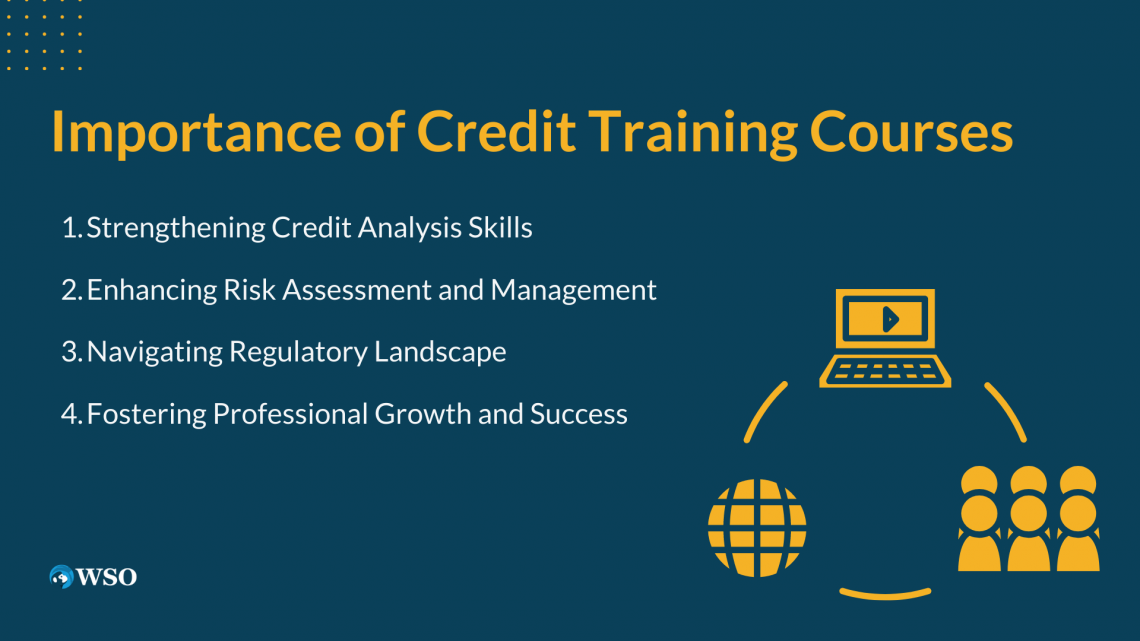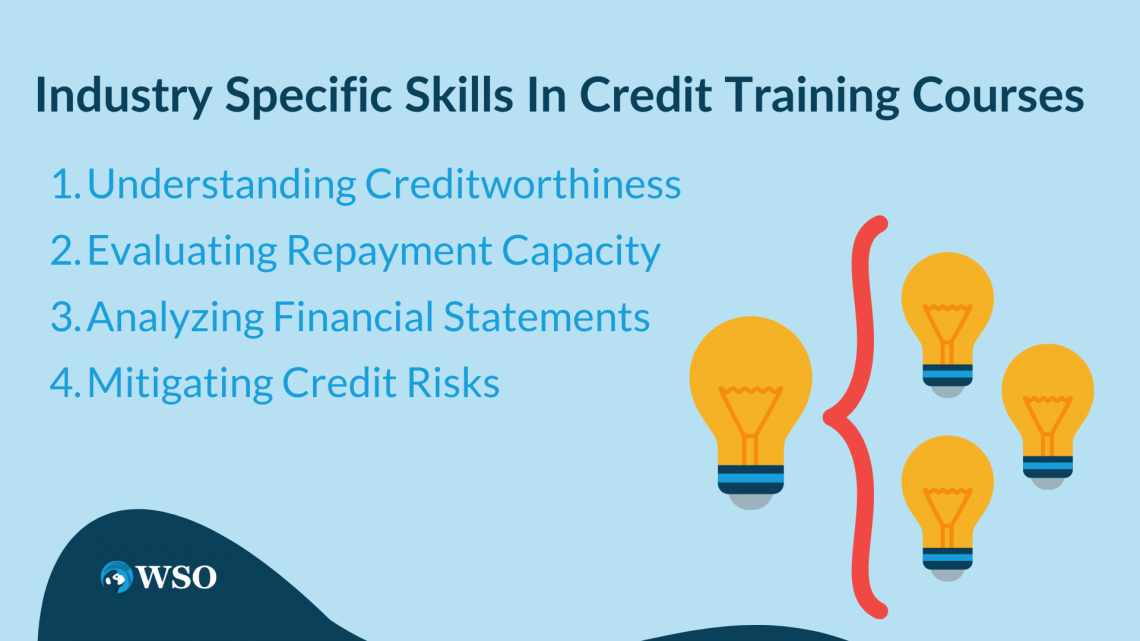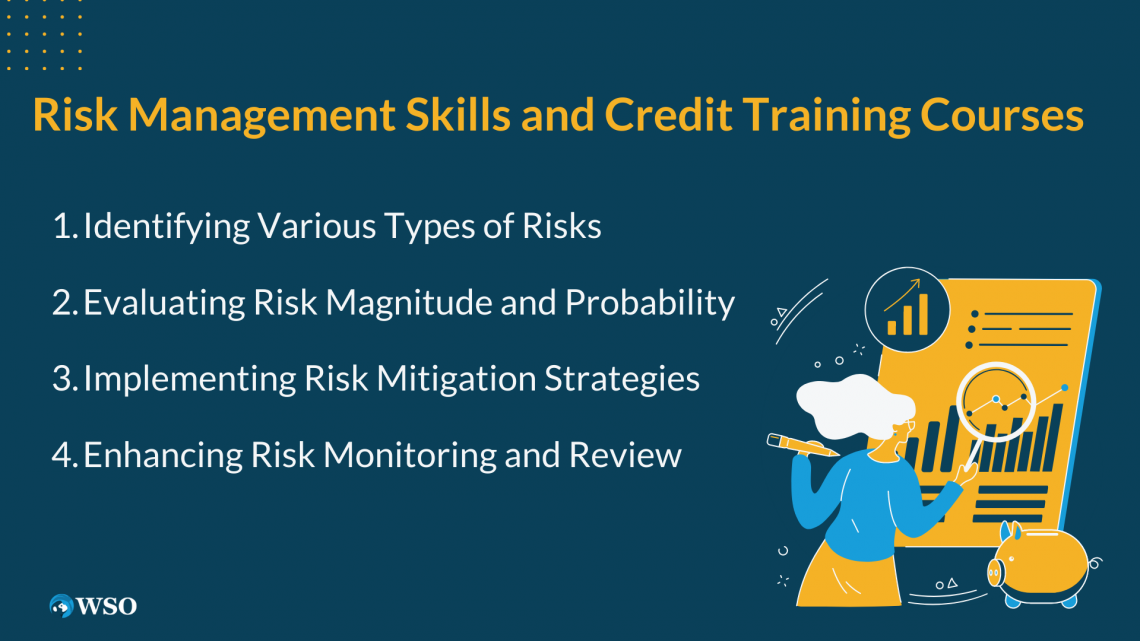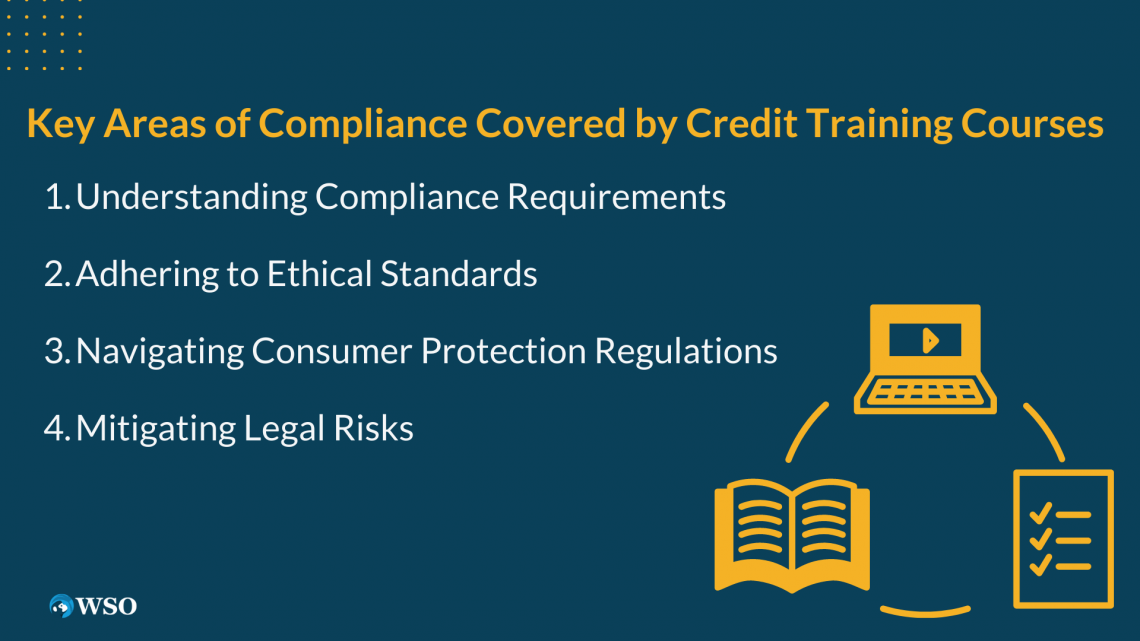Credit Training Courses
It enable professionals to identify risks, make accurate credit judgments, and align lending transactions with their organization's risk appetite.
What Are Credit training Courses?
Credit training courses provide comprehensive training on various aspects of credit analysis, risk assessment, and lending strategies, making them invaluable for professionals seeking to enhance their expertise in this field.

These courses address the unique challenges and complexities of credit evaluation and lending decisions. They offer a structured learning environment that allows participants to dive into the intricacies of credit analysis.
Aside from exploring various risk assessment techniques, participants gain insights into industry best practices.
One of the key benefits of training courses is the opportunity to build strong credit analysis skills. These courses provide participants with a solid foundation in credit analysis methodologies, financial statement analysis, and credit risk assessment.
Through hands-on exercises, case studies, and interactive discussions, professionals can develop a deep understanding of creditworthiness evaluation, repayment capacity assessment, and the factors influencing credit risk.
This enables individuals to identify potential risks, make accurate credit judgments, and structure lending transactions that align with their organization's risk appetite.

Furthermore, training courses also focus on enhancing risk assessment and mitigation strategies. Participants gain insights into various types of risks, including credit, market, and operational risks.
By applying these strategies, professionals can better protect their organizations from potential losses and improve the overall quality of their loan portfolios.
Key Takeaways
- Credit Training Courses enable professionals to identify risks, make accurate credit judgments, and align lending transactions with their organization's risk appetite.
- Strengthening credit analysis skills contributes to accurate credit assessments, risk mitigation, and lending structures.
- Enhancing risk assessment and management allows one to gain insights into various risks, including credit, market, and operational risks.
- Fostering professional growth and success requires continually expanding knowledge and staying updated on best practices.
Importance of Credit Training Courses
Credit training courses are vital for professionals in the credit and lending sector as they aim to enhance their expertise and capabilities in this complex field.

Outlined below are some of the common training objectives that Credit Training Courses hope to achieve:
1. Strengthening Credit Analysis Skills
One of the primary benefits of training courses is the opportunity to develop and strengthen credit analysis skills.
These courses delve deep into various credit analysis methodologies, equipping professionals with the knowledge to assess creditworthiness accurately.
Through interactive sessions and practical exercises, participants learn how to analyze financial statements, evaluate repayment capacity, and identify potential risks.
By honing these skills, individuals become proficient in making informed credit judgments, mitigating risks, and structuring lending transactions in alignment with their organization's risk appetite.
2. Enhancing Risk Assessment and Management
Credit training courses also focus on enhancing risk assessment and management strategies. Professionals gain insights into different types of risks, including credit, market, and operational risks.
They learn effective techniques to identify, measure, and manage these risks to protect their organizations from potential losses.
Note
By applying risk mitigation, transfer, and diversification strategies, individuals can improve the overall quality of their loan portfolios and contribute to sustainable growth.
3. Navigating Regulatory Landscape
The ever-evolving regulatory landscape is a critical aspect covered in training courses. These courses provide individuals with an understanding of relevant laws, industry guidelines, and ethical standards.
Professionals learn to navigate compliance requirements, ensure fair lending practices, and safeguard consumer rights. By staying updated on regulatory changes, individuals can mitigate legal risks, maintain the integrity of lending practices, and foster trust with stakeholders.
4. Fostering Professional Growth and Success
Investing in credit training courses contributes to individuals' professional growth and success in the financial industry.
The acquired knowledge and skills not only enhance their current roles but also open up new opportunities for career advancement within the credit and lending sector.
Credit training courses are indispensable for professionals in the credit and lending sector. By investing in training, professionals can strengthen their skills, adapt to the evolving regulatory landscape, and foster professional growth.
Note
In a competitive industry where accurate credit assessment and risk management are crucial, credit training courses are pivotal in ensuring success and driving the financial sector forward.
Industrial Knowledge and Credit Training Courses
Credit training courses aim to build strong credit analysis skills among professionals in the financial industry.

These courses provide participants with the necessary tools and techniques to evaluate the creditworthiness of borrowers, assess their repayment capacity, and analyze complex financial statements.
Individuals learn to identify potential risks, determine appropriate credit limits, and make well-informed lending decisions by engaging in practical case studies and real-life scenarios.
Listed below are some industry-specific skills that Credit Training Courses aim to instill within trainees:

1. Understanding Creditworthiness
One of the fundamental aspects covered in training courses is understanding creditworthiness. Participants gain a deep understanding of the factors that contribute to an individual or company's creditworthiness.
They learn to assess the borrower's financial stability, cash flow position, and ability to meet debt obligations.
Through a comprehensive analysis of financial statements, professionals can identify trends, ratios, and indicators that signal the borrower's creditworthiness, allowing them to make accurate credit assessments.
2. Evaluating Repayment Capacity
Credit training courses also equip professionals with the skills to evaluate repayment capacity. Participants learn how to analyze income sources, assess debt-to-income ratios, and evaluate borrowers' ability to meet financial obligations.
By considering factors such as employment stability, recurring expenses, and other financial commitments, individuals can determine the borrower's capacity to repay the loan. This analysis is crucial in making informed lending decisions and managing credit risk effectively.
3. Analyzing Financial Statements
An integral part of credit analysis is the ability to analyze financial statements. Credit training courses provide professionals with the knowledge and techniques to interpret financial statements accurately.
Note
Participants learn to assess the borrower's liquidity, profitability, and financial health by examining key financial ratios, cash flow patterns, and balance sheet items.
This in-depth analysis helps individuals identify potential red flags, such as declining revenues, excessive debt levels, or irregularities in financial reporting.
4. Mitigating Credit Risks
Credit training courses emphasize the importance of mitigating credit risks. Professionals learn to identify and assess various types of risks, including credit, industry, and collateral risks.
By understanding these risks, individuals can implement appropriate risk management strategies to protect their organization's financial interests.
This includes structuring loan terms, setting appropriate credit limits, and establishing effective monitoring and review mechanisms. By proactively managing credit risks, professionals can minimize potential losses and optimize overall portfolio performance.
Training courses play a crucial role in building strong credit analysis skills among professionals in the financial industry.
These courses provide participants with the necessary knowledge and tools to evaluate creditworthiness, assess repayment capacity, and analyze complex financial statements.
By developing these skills, individuals can make informed lending decisions, mitigate credit risks, and contribute to the overall financial health of their organizations.
Note
Building strong credit analysis skills is essential in today's dynamic and competitive lending environment, where accurate credit assessments and risk management are vital for success.
Risk Management Skills and Credit Training Courses
Credit training courses prioritize enhancing risk assessment and mitigation strategies for professionals in the financial industry.

By mastering risk management techniques, individuals gain the ability to effectively manage risks associated with lending and safeguard the financial interests of their organizations.
Covered below are some of the risk management skills that Credit Training Courses hone:
1. Identifying Various Types of Risks
In credit training courses, professionals are exposed to a comprehensive understanding of different types of risks. They learn to recognize and assess credit risk, which involves evaluating the likelihood of borrowers defaulting on loan obligations.
Market risk assessment enables individuals to analyze the potential impact of market fluctuations and economic factors on credit portfolios. Operational risk identification evaluates risks arising from internal processes, systems, and human factors.
Note
Professionals can implement appropriate risk management strategies by identifying these risks.
2. Evaluating Risk Magnitude and Probability
Credit training courses provide professionals with the skills to evaluate the magnitude and probability of risks. By understanding the potential impact of each risk type, individuals can prioritize their risk mitigation efforts.
They learn to assess the likelihood of risks materializing and estimate the potential financial and reputational consequences. This enables professionals to make informed decisions regarding risk tolerance and implement proactive measures to mitigate risks effectively.
3. Implementing Risk Mitigation Strategies
Another key aspect covered in training courses is the implementation of risk mitigation strategies. Professionals learn various techniques to minimize the impact of risks on their organizations.
They gain insights into risk transfer strategies, such as insurance and hedging, which help to shift the burden of risk to external parties. Risk diversification techniques are also explored, where professionals learn to spread risks across different borrowers, sectors, and geographies.
By employing these strategies, individuals can optimize their risk exposure and protect their organizations from potential losses.
4. Enhancing Risk Monitoring and Review
Credit training courses emphasize the importance of ongoing risk monitoring and review. Professionals learn how to establish effective risk-monitoring systems, which involve regularly tracking and evaluating credit portfolios.
They gain insights into early warning signs and key performance indicators that help identify emerging risks.
By conducting periodic reviews, professionals can assess the effectiveness of their risk mitigation strategies and make necessary adjustments to ensure continued risk management success.
Training courses provide professionals with the skills to enhance risk assessment and mitigation in the financial industry.
Ongoing risk monitoring and review further strengthen risk management practices and protect their organizations' financial interests.
Note
In today's dynamic and uncertain business environment, assessing and mitigating risks is crucial for maintaining a resilient and successful lending operation.
Keeping Regulations Current with Credit Training Courses
Credit training courses are vital in informing professionals about the constantly changing regulatory landscape in the credit and lending industry.

These courses provide valuable insights into the latest laws, regulations, and industry guidelines that govern credit practices. By staying updated on regulatory changes, professionals can ensure compliance, mitigate legal risks, and maintain the integrity of lending practices.
Here are some key areas of compliance covered by Credit Training Courses:
1. Understanding Compliance Requirements
Training courses focus on equipping professionals with a deep understanding of compliance requirements. Participants learn about the specific regulations and laws for credit and lending operations.
By understanding these requirements, professionals can ensure that their organizations operate within the boundaries of regulatory authorities.
2. Adhering to Ethical Standards
Ethics and integrity are essential aspects of the credit and lending industry. Training courses emphasize the importance of adhering to ethical standards in all aspects of lending practices.
Professionals learn about the ethical considerations in credit assessment, loan origination, and collection processes. They gain insights into maintaining transparency, confidentiality, and fairness throughout the lending cycle.
Note
By upholding ethical standards, professionals build trust with borrowers and stakeholders while safeguarding their organization's reputation.
3. Navigating Consumer Protection Regulations
Consumer protection regulations ensure fair and responsible lending practices. Training courses provide professionals with an understanding of these regulations and how they impact lending operations. Individuals learn about disclosure requirements, interest rate restrictions, and borrower rights.
This knowledge enables professionals to ensure borrowers receive transparent and accurate information, preventing predatory lending practices and fostering a responsible lending culture.
4. Mitigating Legal Risks
By staying informed about regulatory changes, professionals can effectively mitigate legal risks associated with non-compliance. Training courses emphasize the consequences of violating regulations and laws.
Participants learn about the potential legal liabilities that can arise from non-compliant practices.
Professionals can mitigate legal risks and protect their organizations from costly litigation and reputational damage by implementing proper internal controls, maintaining accurate documentation, and adhering to regulatory guidelines.
In the ever-evolving landscape of credit and lending, staying updated on regulatory changes is crucial for professionals in the industry.
Credit training courses provide the necessary knowledge and insights into compliance requirements, ethical standards, and consumer protection regulations.
By understanding and adhering to these regulations, professionals ensure compliance, mitigate legal risks, and maintain the integrity of lending practices. This protects borrowers' interests and safeguards their organizations' reputation and long-term sustainability.
Note
In a dynamic regulatory environment, continuous education and awareness are key to success in the credit and lending industry.
Conclusion
These courses equip individuals with the necessary skills and knowledge to excel in credit analysis, risk assessment, and regulatory compliance.

By enrolling in credit training courses, professionals can enhance their expertise and capabilities, leading to better decision-making and improved lending practices.
One of the key advantages of training courses is the development of strong credit analysis skills. Participants learn how to evaluate the creditworthiness of borrowers, assess repayment capacity, and analyze financial statements.
This enables professionals to identify potential risks, determine appropriate credit limits, and make informed lending decisions based on solid analysis.
Moreover, courses emphasize risk assessment and mitigation strategies. Professionals gain a deeper understanding of various types of risks, such as:
- Credit
- Market
- Operational risks
They learn risk management techniques to manage and mitigate these risks effectively, ensuring the protection of their organizations' financial interests.

Additionally, training courses keep professionals updated on regulatory changes. Staying informed about the latest laws, regulations, and industry guidelines is crucial in the ever-evolving credit and lending landscape.
By understanding and adhering to compliance requirements, professionals can ensure legal compliance, mitigate risks, and maintain the integrity of lending practices.
Credit training courses contribute to individuals' professional growth and success in the financial industry.
The knowledge, skills, and expertise gained through these courses enhance their competence and enable them to make sound credit decisions in a dynamic and competitive market.
By continuously expanding their knowledge and staying updated on best practices, professionals can thrive in their careers and contribute to the success of their organizations in the challenging world of lending.









or Want to Sign up with your social account?